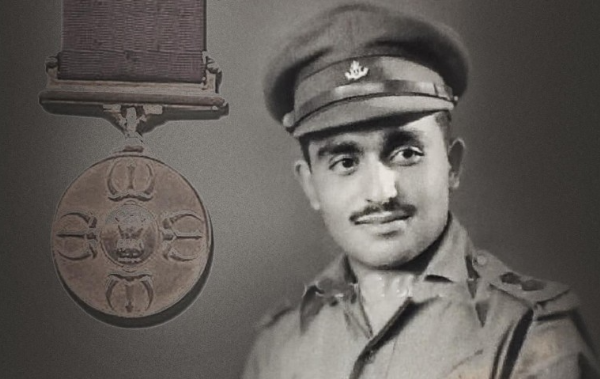Major Somnath Sharma, the first Param Vir Chakra recipient whose heroic sacrifice saved Srinagar: 10 Facts
31 Jan 2024 10:30:57
Born on January 31, 1923, who could have even imagined that at the tender age of 24, Major Somnath Sharma would make the ultimate sacrifice to protect Srinagar earning him the first recipient of Param Vir Chakra, India's highest military decoration, awarded for displaying distinguished acts of valour during wartime.

Badgam held strategic significance as it lay on a route used by Pakistani invaders marching toward Srinagar.
With this valour displayed in the toughest of toughest situations, Majro Somnath Sharma became the recipient of the first "Param Vir Chakra" of Independent India. Coincidentally, the mother-in-law of Major Somnath Sharma’s brother, Savitri Khanolkar was the designer of the Param Vir Chakra.
On 3 November 1947, Major Somnath Sharma's company was ordered on a fighting patrol to Badgam in the Kashmir Valley . He reached his objective at first light on 3 November and took up a position south of Badgam at 11:00 hours. The enemy, estimated at about 500 attacked his company position from three sides; the company began to sustain heavy casualties. Fully realizing the gravity of the situation and the direct threat that would result to both the aerodrome and Srinagar via Hum Hom, Major Somnath Sharma urged his company to fight the enemy tenaciously. With extreme bravery he kept rushing across the open ground to his sections exposing himself to heavy and accurate fire to urge them to hold on. Keeping his nerve, he skilfully directed the fire of his sections into the ever-advancing enemy. He repeatedly exposed himself to the full fury of enemy fire and laid out cloth strips to guide our aircraft onto their targets in full view of the enemy. Realising that casualties had affected the effectiveness of his light automatics, this officer whose left hand was in plaster, personally commenced filling magazines and issuing them to the light machine gunners. A mortar shell landed right in the middle of the ammunition resulting in an explosion that killed him. Major Sharma's company held on to this position and the remnants withdrew only when almost completely surrounded. His inspiring example resulted in the enemy being delayed for six hours, thus gaining time for our reinforcements to get into position at Hum Hom to stem the tide of the enemy advance. His leadership, gallantry and tenacious defence were such that his men were inspired to fight the enemy by seven to one, six hours after this gallant officer had been killed. He has set an example of courage and qualities seldom equalled in the history of the Indian Army. His last message to the Brigade Headquarters a few moments before he was killed was, 'the enemy are only 50 yards from us. We are heavily outnumbered. We are under devastating fire. I shall not withdraw an inch but will fight to the last man and the last round.'

Family and Journey
Battle of Badgam
Badgam held strategic significance as it lay on a route used by Pakistani invaders marching toward Srinagar.
Major Somnath Sharma's valour ensured the safety of Srinagar and, quite possibly, the entire region of Kashmir.
With this valour displayed in the toughest of toughest situations, Majro Somnath Sharma became the recipient of the first "Param Vir Chakra" of Independent India. Coincidentally, the mother-in-law of Major Somnath Sharma’s brother, Savitri Khanolkar was the designer of the Param Vir Chakra.
The official citation reads:
On 3 November 1947, Major Somnath Sharma's company was ordered on a fighting patrol to Badgam in the Kashmir Valley . He reached his objective at first light on 3 November and took up a position south of Badgam at 11:00 hours. The enemy, estimated at about 500 attacked his company position from three sides; the company began to sustain heavy casualties. Fully realizing the gravity of the situation and the direct threat that would result to both the aerodrome and Srinagar via Hum Hom, Major Somnath Sharma urged his company to fight the enemy tenaciously. With extreme bravery he kept rushing across the open ground to his sections exposing himself to heavy and accurate fire to urge them to hold on. Keeping his nerve, he skilfully directed the fire of his sections into the ever-advancing enemy. He repeatedly exposed himself to the full fury of enemy fire and laid out cloth strips to guide our aircraft onto their targets in full view of the enemy. Realising that casualties had affected the effectiveness of his light automatics, this officer whose left hand was in plaster, personally commenced filling magazines and issuing them to the light machine gunners. A mortar shell landed right in the middle of the ammunition resulting in an explosion that killed him. Major Sharma's company held on to this position and the remnants withdrew only when almost completely surrounded. His inspiring example resulted in the enemy being delayed for six hours, thus gaining time for our reinforcements to get into position at Hum Hom to stem the tide of the enemy advance. His leadership, gallantry and tenacious defence were such that his men were inspired to fight the enemy by seven to one, six hours after this gallant officer had been killed. He has set an example of courage and qualities seldom equalled in the history of the Indian Army. His last message to the Brigade Headquarters a few moments before he was killed was, 'the enemy are only 50 yards from us. We are heavily outnumbered. We are under devastating fire. I shall not withdraw an inch but will fight to the last man and the last round.'
On his birth anniversary, let us salute his legacy of bravery, leadership, and indomitable spirit that will continue to inspire generations, reminding us that heroes live on in the hearts of their grateful nation.